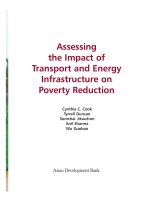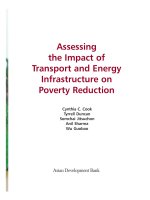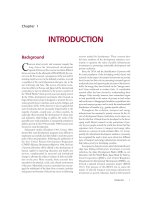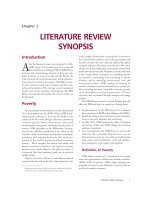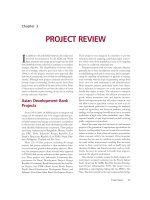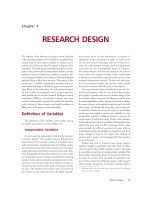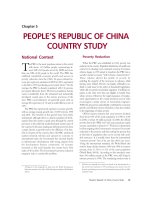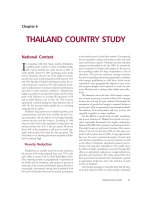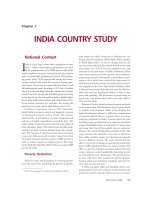alhazaimeh et al - 2014 - the impact of cg and ownership structre on voluntary disclosure in annual reports among listed jordanian companies
Bạn đang xem bản rút gọn của tài liệu. Xem và tải ngay bản đầy đủ của tài liệu tại đây (312.66 KB, 8 trang )
Procedia - Social and Behavioral Sciences 129 ( 2014 ) 341 – 348
Available online at www.sciencedirect.com
1877-0428 © 2014 The Authors. Published by Elsevier Ltd. This is an open access article under the CC BY-NC-ND license
( />Selection and peer-review under responsibility of Universiti Malaysia Kelantan
doi: 10.1016/j.sbspro.2014.03.686
ScienceDirect
ICIMTR 2013
International Conference on Innovation, Management and Technology Research,
Malaysia, 22 – 23 September, 2013
The Impact of Corporate Governance and Ownership
Structure on Voluntary Disclosure in Annual Reports
among Listed Jordanian Companies
Amer Alhazaimeh, Ravindran Palaniappan, Mahmoud
Almsafir
*
aGraduate Basiness School,College of Graduate Studies , Tenaga National University, Jalan IKRAM-UNITEN,43000 Kajang,
Selangor,Malaysia
Abstract
In the new economy, companies try to convey to their stakeholders that they are a good investment and Attempt
highlight the good value of the company via disclosure of pertinent information in the annual reports. This paper
investigates the relationship between corporate governance and ownership structure on voluntary disclosure, with a
particular focus on variables affecting in voluntary disclosure of listed companies in the Amman Stock Exchange
(ASE). Using a dynamic panel system GMM estimation for the period 2002-2011, this study of 72 Jordanian finds
that the listed companies at ASE during 2002-2011 had shown a significant degree of voluntary disclosure in line
with greater corporate governance awareness and implementation in Jordan. In particular, this paper found board
activity, foreign ownership, non –executive directors and block holder ownership to be significant in influencing
voluntary disclosure. Finally, this paper found that the voluntary disclosure in the annual reports does potentially
affect the market capitalization.
© 2013 Published by Elsevier Ltd. Selection and peer-review under responsibility of Universiti Malaysia
Kelantan, Malaysia
Keywords: Corporate governance, ownership, voluntary disclosure, dynamic panel data
1. Introduction
Accounting disclosure is very important to all stakeholders; it provides them with the necessary
information to reduce uncertainty and helps them to make suitable economic and financial decisions. The
annual financial reports published by companies are considered one of the most important sources of
information to outsiders (Betosan 1997). Annual reports are used as a communication tool to
*
Corresponding author. Tel.: +60133898103
E-mail address:
© 2014 The Authors. Published by Elsevier Ltd. This is an open access article under the CC BY-NC-ND license
( />Selection and peer-review under responsibility of Universiti Malaysia Kelantan
342 Amer Alhazaimeh et al. / Procedia - Social and Behavioral Sciences 129 ( 2014 ) 341 – 348
communicate both quantitative and qualitative corporate information with stakeholders or with other
interested parties (Barko, Hancock & Izan, 2006).
T
hese financial reports include information that may help in recognizing the financial position of the
company, reflect the operation, structural and financial picture of the corporations to the stakeholders;,
sometime the information
’s provided may not be useful enough to meet the needs of some beneficiaries
like investors, creditors, customers and the public, and anybody who is interested in the success of
corporations. Disclosure within financial reports can be classified into two parts: mandatory and
vo
luntary (non- mandatory) disclosure. Mandatory disclosure which is as any financial item disclosed
within companies annual reports that are prescribed by accounting standards and / or the stock exchange
re
gulations (Penmann, 1988). Voluntary disclosure means making public the financial and non-financial
information regarding a firm’s operations without any legal requirement (Botosan, 1997; Naser &
Nuseibeh, 2003; Alsaeed, 2006). Nasir, N. (2004) understanding why companies voluntarily disclose
in
formation is useful for both producers and users of accounting information, as well as for accounting
pol
icy (Buzbee, 1975; Meek, Gray & Roberts, 1995).
Therefore, evidently today, various stock exchanges around the world require companies to prepare
financial reports, with the objective to providing important stakeholders with timely and high quality
financial information to help them make informed financing and investing decisions. In this context,
Jordan has begun to implement the same financial procedure. Globalization has become the key word in
the new world economy. Technology, communication and intense flow of information and trading across
borders all make the world a small village; Jordan realizes that it needs to consider and adopt positive
changes in order to be at par with other nations. Indeed, Jordan was one of the few countries in the Middle
East to realize the importance of coping with the new trends of change occurring in the world. It is the
first Arab country to join the Board of Directors of the International Accounting Standards Committee
(IASC) in 1988, and has over the last 20 years since 1990 been practicing the International Accounting
Standards (Naser, Al-Khatib, & Karbhari, 2002).
The rest of the paper is structured as follows: Section 2 provides the literature review on corporate
governance and ownership. Section 3 describes research methodology, Section 4 presents the empirical
results, and finally Section 5 provides a summary and some conclusions.
2. Literature Review
Corporate governance has been in the spotlight for the past decade. Numerous scandals, such as
th
oseinvolving Enron, Tyco, Imclone Systems, WorldCom, exposed failures in corporate governance
that shook the capital markets in developed countries. Restoration of public confidence or trust becomes
the main agenda for today's business leaders (Heidi & Marlene, 2003). Disclosing more information on
the company's capital structure and control can be an important way to achieve that goal (Rogers, 2006).
Beasley, et, al. (2000) emphasis the crucial role of full disclosure in avoiding financial reporting
fraud. Guan, et al.(2007) find that to protect investors' rights and enhance information transparency, the
regulatory authorities of securities markets and information intermediaries have exerted great effort to
advocate corporate governance, thus lessening the occurrence of adverse selection and agency problems
as a result of the information asymmetry. Corporate governance has been studied as a mechanism which
affects corporate disclosure. Transparency, openness, disclosure and trust, which form the integral part of
corporate governance, can exert pressures to improve financial performance (Rogers, 2006).
343
Amer Alhazaimeh et al. / Procedia - Social and Behavioral Sciences 129 ( 2014 ) 341 – 348
According to Archambault & Archambault, (2003), the level of accounting disclosure differs from
one country to another and from one company to another in the same country. This is controlled by the
different standards and regulations governing the disclosure of accounting to be followed and the degree
of flexibility of their applicability. One important consequence of these differences is that it may
negatively affect the quality of investment decisions based on information contained in the financial
report. Improving the high level of disclosure information is positively thought to affect the investors’
confidence.
Fama & Jensen (1983) and Jensen & Meckling, (1976) theorize that corporate governance
mechanisms that are well practiced could benefit shareholders financially by exercising more
con
trol on the company’s ma
nagement. Moreover, the corporate governance characteristics can be seen
as proxies for independence and the alignment of interests between management and the shareholders in
minimizing the agency conflict.
Ow
nership structure is also considered one of the factors that affect the quality of the financial
reporting process. According to Eng and Mak (2003), the structure of ownership determines the
le
vel of monitoring, and thereby the level of disclosure.
Many scholarly articles have been written and devoted more attention recently to the impact of
corporate governance characteristics on voluntary disclosure among listed corporations in both developed
and developing countries. They also draw attention to weak corporate governance in developing,
em
erging and transnational economies (Bremer & Elias, 2007). Due to the fact that no previous studies
we
re keen to examine the impact of corporate governance characteristics, ownership structure and the
ex
tent of voluntary disclosure in Middle Eastern countries in general and Jordan in particular, this study
ho
pes to bridge the gap Unlike the United States, the United Kingdom and Europe. This research is
considered important for this region, because companies in this region have less incentive for
tr
ansparent and frequent disclosure than their Anglo-American and European counterparts.
3. Research Methodology
3.1 Data
This study focuses on financial reports provided by companies listed on the Amman Stock Exchange
(ASE) as per required by the Directives for Listing Securities on ASE for the period (2001-2010)
regulations. This study will be applied on 73 non- financial companies listed in Amman stock exchange.
On the other hand, the financial sector is not included because it has special regulations pertaining to
financial reporting, issued from Jordan Central Bank and the Insurance Commission.
Th
e selection of the period (2002 to 2011) was made due to the following reasons. First, the year 2002
was chosen according to Securities Law No.76 of 2002 was issued to support the voluntary disclosure.
Second, the year 2011 was also chosen because the 2011 annual reports are considered as the latest source
of
information available at the time of the study for the entire sample. Data was gathered from the annual
reports of selected companies and the data also obtained through the Bloomberg databases, for the period
2002-2011, and other data from other resources like Jordan Securities Commission and Amman Stock
Ex
change.
344 Amer Alhazaimeh et al. / Procedia - Social and Behavioral Sciences 129 ( 2014 ) 341 – 348
3.2 Variables Definitions
Table 1 report briefly discusses the specific definitions of the variables used in
this paper.
VARIABLE
ACRONYM
MEASUREMENT
Voluntary disclosure
(VDI)
The disclosure index is used to measure the extent of voluntary
disclosure (Cooke, (1989); Meek et al, (1995); Ghazali
&W
eetman, (2006); Haniffa & Cooke,(2002)and Nassir,(2004); Al-
Shammari, (2008).
Audit committee
(ACOM)
Audit committee data will be coded (1) to indicate existence of
audit committee and (0) to indicate non-existence (Ho & Wong,
2001, Dezoort, 1997 and Wolnizer, 1995).
Board compensation
(BCOM)
Board compensation is measured by the log of the total amount
of compensation given to the board of directors for each company.
Board activity
(BACT)
Board activity is measured as the number of meetings of the
board of directors per year (Anderson (2005).
Board size
(BSIZE)
Board size is derived by counting the total number of directors
on the board (Bushman, Chen, Engel, & Smith, 2004).
Non –executive directors
(NEXED)
Percentage of non –executive directors will be measured by
dividing the number of non-executive directors with total number of
directors on the board (Franks, Mayer, & Renneboog,
2001). Chen & Jaggi (2000) and Haniffa & Cooke (2002).
Large audit firm
(LAUD)
Large audit firm will be measured by (1) if company has audited
from big 4 audit firms and (0) if otherwise (Jensen & Meckling,
1976; Watts & Zimmerman, 1986).
Foreign ownership
(FOW)
Foreign ownership will be measured by log of percentage of shares owned
by foreigners to total number of shares issued, following (Haniffa and
Cooke, 2002; Wang et al, 2008).
Government ownership
(GOW)
Government ownership will be measure by percentage of shares
owned by government to total number of shares issued, following
(Cheng and Courtenay, 2006; Eng and Mak, 2003; Wang et al, 2008).
Block holder ownership
(BLK)
Block holder ownership measured by calculating the proportion
of shares held by institutional investors; this proportion must equal or
exceed 5% of total shares. Eng and Mak (2003).
Number of shareholders
(NSHA)
Number of shareholders measured by counting the total number
of the shareholders for each company (Al Muhannadi, 2004; Gharaebeh &
Naber, 1987; Malone, Fries, & Jones, 1993; Singhvi & Desai, 1971).
3.3 Dynamic Panel GMM
Generalized Method of Moments (GMM) is a dynamic panel approach which takes account of
the impact of past voluntary disclosures on the current one. It employs a sample with a short time-period
but a large number of firms. System GMM was developed by Arellano and Bover (1995) and Blundell
and Bond (1998) to improve the efficiency of first difference GMM developed by Arellano and Bond
(1991). It consists of two equations of level and first difference that each one adopts Instrumental
Variables (IV) to remove the correlation between explanatory variables and residuals. Generally
speaking, GMM approach has salient advantages in dealing with short-sample periods, heteroskedasticity,
autocorrelation, and heterogeneity, endogenous and predetermined explanatory variables. Hence, it
improves the efficiency of the estimates dramatically. The success of the GMM estimator in producing
unbiased, consistent and efficient results is highly dependent on the adoption of the appropriate
instruments. Therefore, there are three diagnostic tests; namely Hansen/Sargan test of over identifying
restrictions, AR (2), and the difference in Hansen test.
345
Amer Alhazaimeh et al. / Procedia - Social and Behavioral Sciences 129 ( 2014 ) 341 – 348
First, the Hansen/Sargan test of over-identifying restrictions examines the overall validity of the
instruments by analyzing the sample analogue of the moments conditions used in the estimation
process. If the moment condition holds, then the instrument is valid and the model has been correctly
specified. Second, AR (2) conducts a test on residuals to show whether there is no serial correlation
am
ong the transformed error terms. Third, to test the validity of extra moment’s
conditions on the
system GMM, the difference in Hansen test is used. This test measures the difference between the
Hansen statistic generated from the system GMM and the difference GMM. Failure to reject the three
null hypotheses gives support to the estimated model
4. Results
Table 2 reports the estimated results of the determinants of voluntary disclosure using two-step
system GMM. The results indicate voluntary disclosure has a trend over time by which past voluntary
di
sclosure significantly influences the current one. Nevertheless, some factors concurrently affect
di
sclosures, such as board compensation, foreign ownership, government ownership, and block holder
o
wnership. For instance, block holder ownership negatively and significantly reduces voluntary
di
sclosures. Specifically, an increase in the block holder ownership leads to a contemporaneously
decline in the voluntary disclosure by 0.04228 point. Higher board compensation and foreign
ow
nership urge firms to disclose their information voluntarily. The results imply insignificant
coefficients for some factors, such as audit committee, board activity, and non –executive directors in
spite of our expectation of significant contribution to the voluntary disclosure. It can be due to the fact
that they are still far from their efficient points which require policy makers and managers to adopt
strategies to facilitate the process of disclosure.
The results of the both specification tests that are AR (2) for testing the serial correlation and the
Hansen test for testing the validity of instrument adopted are also valid. As shown in Table 2, the p-values
for the AR (2) and Hansen tests are higher than 0.10, that is, statistically insignificant at the ten percent
significance level. This implies that the empirical model has been correctly specified because there is no
serial correlation (autocorrelation) in the transformed residuals, and the instruments (moments conditions)
use
d in the models are valid. The additional moment conditions such as difference in Hansen tests are
also statistically insignificant but not reported in order to save space.
Table 2: The Determinants of Voluntary Disclosure: Two-Step System GMM
Coefficients
Standard Error
P-Value
Voluntary index
0.22461***
0.01455
0
Audit committee
0.59656
0.98710
0.546
Board compensation
0.00003**
0.00001
0.032
Board activity
0.21840
0.17590
0.214
Board size
0.02137
0.16490
0.897
Non –executive directors
0.73462
1.18703
0.536
Number of employee
0.00022
0.00039
0.568
Foreign ownership
0.05998***
0.01301
0
Government ownership
0.05019***
0.00893
0
Number of shareholders
0.00003
0.00004
0.493
Block holder
-0.04228***
0.01476
0.004
Economic Freedom
1.65412
0.13970
0
Number of instruments
56
Number of observations
598
Number of groups
72
AR(2)-p value
0.350
Hansen/Sargan test –p value
0.563
*, **, *** denote 10%, 5% and 1% significant levels, respectively. Year dummies and constant are
not included in order to save space. All p-values of the difference in Hansen tests of
ex
ogeneity of instruments subsets have also been rejected at least at 10 percent significant level.
346 Amer Alhazaimeh et al. / Procedia - Social and Behavioral Sciences 129 ( 2014 ) 341 – 348
5. Conclusion
The role of voluntary disclosure has been studied extensively in advanced countries; however
little attention has been given to investigating this issue in a small-open economy. Therefore, to fill this
gap in the previous literature, this study focuses on the relationship between corporate
go
vernance and ownership structure on voluntary disclosure in annual reports among listed Jordanian
co
mpanies using a dynamic panel data framework.
This paper aims to shed light on the determinants of the extent of voluntary disclosure in the
Jordanian listed firms for the period (2002-2011). Findings reveal that Jordanian companies adopt
vo
luntary disclosure on different types of information. This paper additionally examined the effect of
corporate governance and ownership structure on the extent of voluntary disclosure. The results indicate
vo
luntary disclosure has a trend over time by which past voluntary disclosure significantly influences
t
he current one. Nevertheless, some factors concurrently affect disclosures, such as board compensation,
foreign ownership, government ownership, and block holder ownership. For instance, block holder
ow
nership negatively and significantly reduces voluntary disclosures. The study also reveals that larger
co
mpanies disclose more information than smaller companies in Jordan.
References
Al
Muhannadi, M. (2004). The effect of accounting disclosure in released annual financial reports on
stock prices- applied study in Jordanian industrial joint-stock companies. Al Al Bayet University,
Mafraq-Jordan.: Unpublished master's thesis.
Alsaeed, K. (2006). The association between firm-specific characteristics and disclosure: The case of
Saudi Arabia. Managerial Auditing Journal, 21(5), 476-496.
Al
-Shammari, B. (2008). Voluntary disclosure in Kuwait corporate annual reports. Review of Business
Re
search, 8 (1), 62 – 81.
Anderson, M. (2005).corporate governance disclosure by Swedish listed corporations .Fredrik Ljungdahl
toured.
Ar
chambault, J & Archambault, M. (2003). A Multinational Test of Determinants of Corporate
Disclosure. International Journal of Accounting, 38(2), 173-194.
Arellano, M. & Bond, S. (1991). some tests of specification for panel data: Monte Carlo evidence and an
application to employment equations. Review of Economic Studies, 58, 277-297.
Arellano, M. & Bover, O. (1995). another look at the instrumental-variable estimation of error-
co
mponents models. Journal of Econometric, 68, 29-52.
Ba
rako, D. G., Hancock, P., & Izan, H. Y. (2006). Factors influencing voluntary corporate disclosure by
Kenyan companies. Corporate Governance, 14, 2, 107-125.
Beasley M., Carcello, J, Hermanson, D. & Lapides, P. (2000). Fraudulent financial reporting:
consideration of industry traits and corporate governance mechanisms. Accounting Horizons, 14(4), 441-
454.
Blundell, R. & Bond, S. (1998). Initial conditions and moment restrictions in dynamic panel data
models. Journal of Econometrics, 87, 115-143.
Bot
osan, C.A. (1997). Disclosure level and the cost of equity capital. The Accounting Review, 72 (3),
323-349.
Bre
mer, J., & Ellias, N. (2007). “Corporate Governance in Developing Economies –Th
e Case of
Egypt.”.International Journal of Business Governance and Ethics, 3(4), 430-445.
347
Amer Alhazaimeh et al. / Procedia - Social and Behavioral Sciences 129 ( 2014 ) 341 – 348
Bushman, R, Chen, Q. Engel, E and Smith, A. (2004), ‘Financial Accounting Information,
Organizational Complexity and Corporate Governance Systems’, Journal of Accounting and
Economics, 37(2),167–201
Bu
zby, S. (1975). Company size, listed versus unlisted stocks, and the extent of financial disclosure.
Journal of Accounting Research, 75(1), 16-37.
Chen, J.P., Charles & Jaggi, B. L. (2000). The Association between independent nonexecutive directors,
family control and financial disclosures in Hong Kong. Journal of Accounting and Public Policy, 19(4-5),
285-310.
Cheng, E. C. M., & Courtenay, S. M. (2006). Board composition, regulatory regime and voluntary
disclosure. The International Journal of Accounting, 41(3), 262-289.
DeZoort, F. T., (1997). An investigation of audit committees’ ov
ersight responsibilities. Abacus, 33, 208-
27.
Eng, L., & Mak, Y. (2003). Corporate governance and voluntary disclosure. Journal of Accounting and
Pu
blic Policy, 22(4), 325-345.
Fa
ma, E., & Jensen, M. (1983). Separation of ownership and control. The journal of law and Economics,
26(2), 301-326.
Ghazali, N. & Weetman, P. (2006). Perpetuating traditional influences: Voluntary disclosure in Malaysia.
Journal of International Accounting Auditing and Taxation 15 (2), 226 – 248.
G
uan Yue-Duan., Sheu Dwan-Fang & Chu, Yu-Chin. (2007). Ownership Structure, Broad of Directors,
and Information Disclosure. Journal of American Academy of Business, Cambridge: ABI/INFORM
G
lobal pg. 182.
Haniffa, R. M., & Cooke, T. E. (2002). Culture, Corporate Governance and Disclosure in Malaysian
Corporations. Abacus, 38(3), 317-349.
Heidi, V. B. & Marleen, W. (2003). Voluntary Disclosure on Corporate Governance in the European
Un
ion. Dept of Applied Economics, University of London.
Ho, S.,
& Wong, K.S. (2001). A study of the relationship between corporate governance structures and
the extent of voluntary disclosure. Journal of International Accounting, Auditing and Taxation, 10(2),
139-156
Jensen, M. C, & Meckling, W. H. (1976). Theory of the firm: Managerial behavior, agency cost and
ownership structure. Journal of Financial Economics, 3(4), 305-360.
Malone, D., Fries, C, & Jones. T. (1993). An empirical investigation of the extent of corporate financial
disclosure in the oil and gas industry. Journal of Accounting, Auditing and Finance, 8(3), 249-273.
Meek, G. K., Roberts, C. B. and Gray, S. J. (1995). Factors influencing voluntary annual report
disclosures by US, UK and Continental European multinational corporations. Journal of International
Business Studies, 26 (3), 555 – 572.
Naser, K., & Nuseibah, R. (2003). Uality of Financial Reporting: Evidence from the Listed Saudi
No
nfinancial Companies Q. International Journal of Accounting, 38(1), 41-69.
Naser, K., Al-Khatib, K., & Karbhari, Y. (2002). Empirical evidence on the depth of corporate
information disclosure in developing countries: The case of Jordan. International Journal of Commerce
and Management, 12(3), 122-155
348 Amer Alhazaimeh et al. / Procedia - Social and Behavioral Sciences 129 ( 2014 ) 341 – 348
Nasir, N. (2004). Voluntary disclosure and corporate governance among financially distressed firms in
Malaysia. Monash University Malaysia.
Pe
nmen, S.H. (1988). An empirical investigation of the voluntary disclosure of corporate earning
forecasts, Journal of accounting research.
Ro
gers, M. (2006). Corporate Governance and Financial Performance of Selected Commercial Banks in
Ug
anda. Makerere University Business School, Faculty of Commerce. East Africa: Kampala Uganda.
Singhvi, S. S., & Desai, H. B. (1971). An empirical analysis of the quality of corporate financial
disclosure. Accounting Review, 46(1), 129-138.
Wang, K., Sewon, O., & Claiborne, M. (2008). Determinants and consequences of voluntary disclosure in
an emerging market: Evidence from China. Journal of International Accounting, Auditing and Taxation,
77(1), 14-30.
Wo
lnizer, P. (1995). Are Audit Committees Red Herrings? Abacus.31 (1), 45-66.
Xiao, J. Z., Yang, H., & Chow, C. W. (2004). The determinants and characteristics of voluntary Internet-
based disclosures by listed Chinese companies. Journal of Accounting and Public Policy, 23(3), 191-225.
